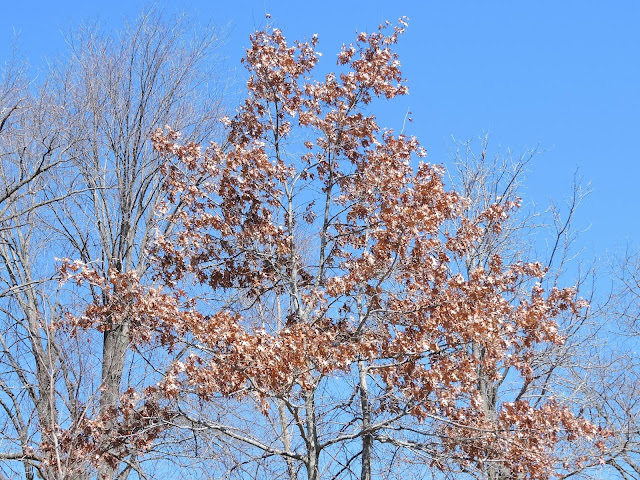The return of the song sparrow is an encouraging sign and sound of spring. They have a distinctive song and usually perch where they can be easily seen as they sing. They can be identified by their streaky breast with a central brown spot.
There are still sounds that are more reminiscent of fall; the rustle of the oak leaves that remain on the trees as well as the leaves on the ground that are now freed of their snow cover. They are light and brittle and the wind swirls them across the path.
I paused by a pine tree when I heard clicking sounds. It took time to realize that the sound was coming from the female cones, opening a scale at a time in the warmth of the sun. Fascinating!
The river is ice-free and appears calm, but the volume of water is still high. From this vantage point above the river I can see the changes that have been made by flood waters, ice and wind. The trees on the island are so damaged that high perches are no longer available to the bald eagles. The river bank on the far side has been carved away so that it is now much steeper.
Even though the river looks quiet, its surface is broken regularly by the ripples of diving ducks like Common Goldeneyes and Common Mergansers.
Today there was also a solitary Mute Swan...
and as usual a complement of noisy Canada Geese. These birds generally mate for life and do not breed until their fourth year. A nest is constructed on the ground or possibly on an obliging muskrat's mound. The riverbank and its islands are locations fraught with danger if all the ice has not yet cleared the river system.
This little patch of sunshine is winter aconite, which will push up through the snow to bloom even earlier than crocuses. These have probably escaped from a local garden and naturalized by the path, a little spring serendipity.
Skunk cabbage is still emerging in low-lying areas and often one of those first glimpses of spring colour. As the plant matures, the hooded spathe opens up to allow insects access to the inner spadix which is covered with tiny flowers that need to be pollinated.
In a shallow ditch, on a more protected section of path, the increased warmth was pushing the production of leaves on the skunk cabbages ahead.
The purple scales of the wildflower Coltsfoot were also pushing up through the dead grass in response to this warmth. The flowers are similar to dandelions in their colour and basic shape; little circles of sunshine.
It crossed my mind that as spring advanced, there would be some special things that would no longer be visible, such as little tracks that evidenced the movement of critters across the landscape.
Seedpods, like this one from the prickly honey locust tree will degrade...
cocoons will open and release their inhabitants..
and entrances to chipmunk dwellings will become less obvious.
More colourful blossoms may distract from less obvious plants like the primeval liverwort..
or the tiny moss sporophytes...
and even this vivid patch of orange iron bacteria in the ditch will disappear beneath the plants and reeds that will soon grow up there.
Given the fact that there will always be dishes to wash, clothes to launder and floors to vacuum, a strong argument can be made for spending a little time each day to capture those things that are fleeting. Maybe a wildflower..or a wee boy at just this age..the shape of a tree..or the sound of that first song sparrow. I think I will continue to heed that siren call.
























No comments:
Post a Comment